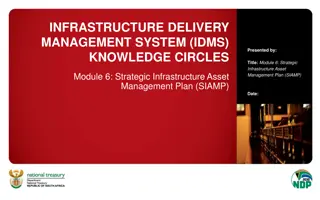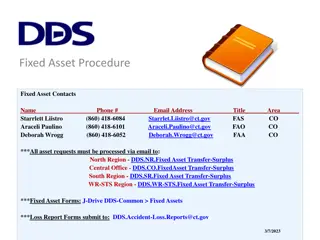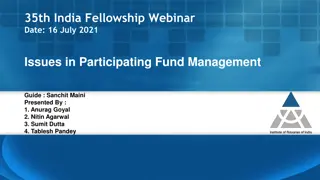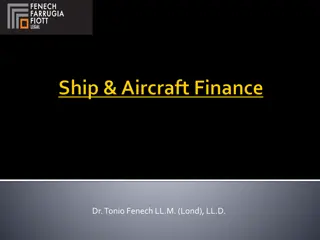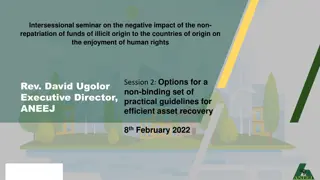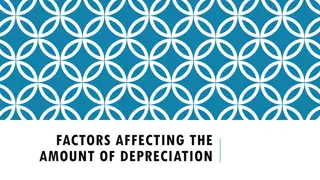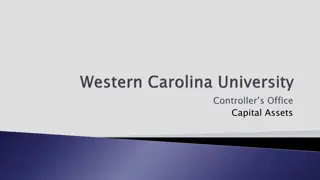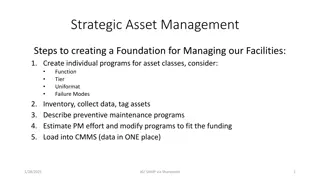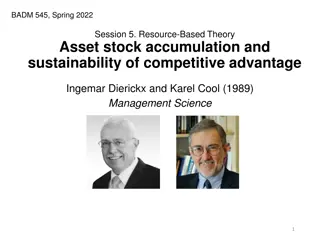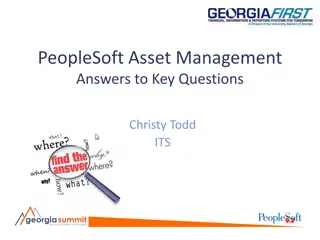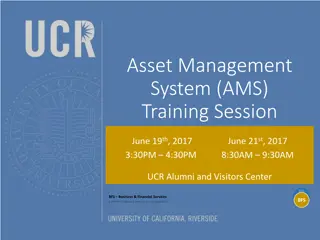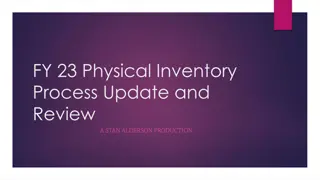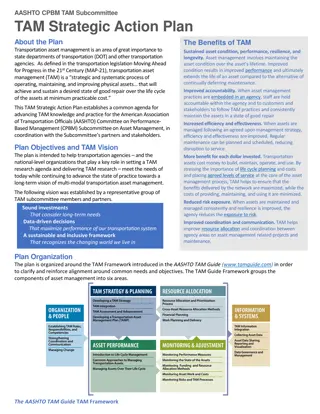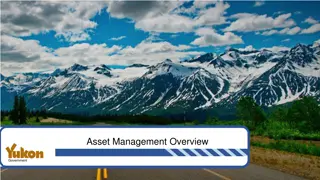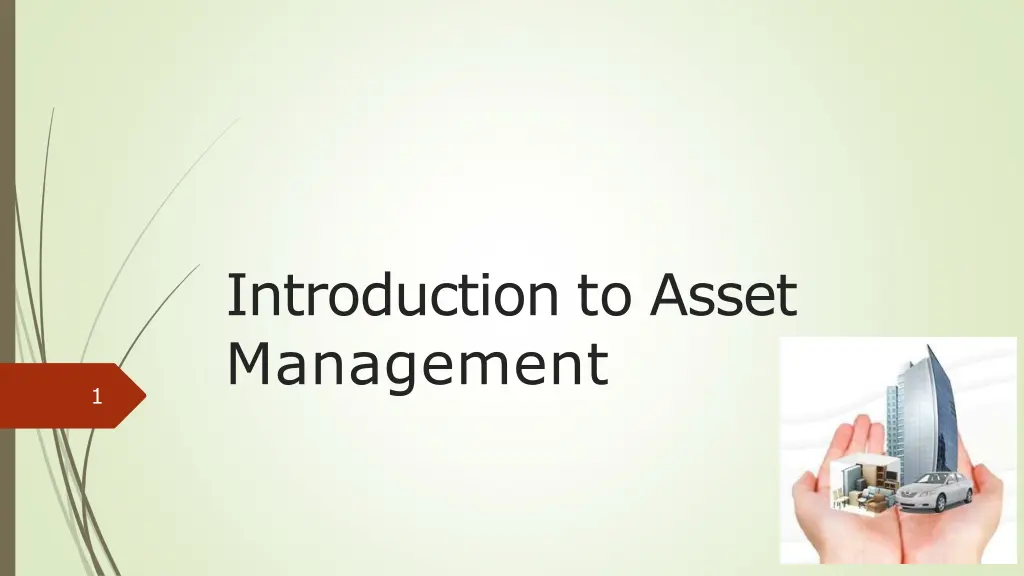
Understanding Asset Management Fundamentals
Learn about asset management basics including the main concepts, types of assets, nature of assets, and the importance of assets within organizations. Explore the definitions, classifications, and characteristics of assets, essential for effective management strategies.
Download Presentation

Please find below an Image/Link to download the presentation.
The content on the website is provided AS IS for your information and personal use only. It may not be sold, licensed, or shared on other websites without obtaining consent from the author. If you encounter any issues during the download, it is possible that the publisher has removed the file from their server.
You are allowed to download the files provided on this website for personal or commercial use, subject to the condition that they are used lawfully. All files are the property of their respective owners.
The content on the website is provided AS IS for your information and personal use only. It may not be sold, licensed, or shared on other websites without obtaining consent from the author.
E N D
Presentation Transcript
Introduction to Asset Management 1
Chapter Aim 2 To introduce to the main concept of asset management. ?
Chapter Objectives 3 To understand the broad types of assets which organizations have. To know the types of industry to which asset management is particularly important. To define assets, liabilities and related terms from an accounting viewpoint. To define asset management. To outline the asset management life cycle. To know the place of asset management within and throughout an organizational structure. To be aware of the dangers of the asset death spiral. ? ? ? ? ? ? ?
What is an Asset 4 ? Something that has potential or actual value to an organization. So it can be Tangible or Intangible. ? Can have Present or Future Value. ? Value is what left after paying the price. ? And value created shall be in good fit with vision ? and strategic objectives of organization.
Types of asset within organization 5 Financial assets Physical assets Intangible assets Type of assets Human assets Information assets
Nature of Assets 6 Human assets: The behaviors , knowledge and Competence of the workforce have a fundamental (influence on the performance of the physical assets) ? Financial assets: financial resources are required for infrastructure investments, operation, maintenance and materials; ? Information assets: good quality data and information are essential to develop, optimize and implement asset management plan(s); ? Intangible assets: the organization s reputation and image can have a significant impact on infrastructure investment, operating strategies and associated costs. ? Plants, Machinery, Building, Physical Assets : ? vehicles, property and other items with
What is an Asset? 7 Physical asset: ? Assets to serve a business or organizational function. Link closely with financial management. Fixed asset: ? a physical item which has value over a period exceeding one year. Example: land, building, plant, machinery Current asset: ? faster moving asset Example: cash, inventory (materials, work in progress, finished goods, consumables)
What is an Asset? 8 Expense: ? Money or assets consumed in generating sales or service in the current year. Examples: wages, materials and overhead costs. Liabilities: ? Money that we owe. Examples: bills for recent purchases, short-term loans, long- term loans Equity: ? net value of the company after the liabilities are subtracted from the assets. Equity = Assets - Liabilities
Example of Physical Assets 9 Plant Information Systems & Software Machinery Wires Buildings Pipes Vehicles
What Is Asset Management 10 Systematic and coordinated activities and practices through which an organization optimally and sustainably manages its assets and asset systems, their associated performance, risks and expenditures over their life cycles for the purpose of achieving its organizational strategic plan.
Enterprise Asset Management Infrastructure Asset Management Physical Asset Management Strategic Asset Management Property Asset Management Facilities Asset Management, and many others 11 The emerging standards converge the opinion to the term Asset Management
What is Asset Management? 12 Asset management is the set of activities associated ? with: Identifying what assets are needed Identifying funding requirements Acquiring assets Providing logistic and maintenance support systems for assets Disposing or renewing assets
What is Asset Management? 13 Asset management council of Australia: The life cycle management of physical assets to achieve the stated outputs of the enterprise . ? PAS 55, British Standards Institute systematic and coordinated activities and practices through which an organization optimally and sustainably manages its assets and asset systems, their associated performance, risks and expenditures over their lifecycles for the purpose of achieving its organizational strategic plan. ?
Why do we need Asset Management? To provide asset knowledge and the capacity for related management and decision support activities within the context of the business 14 ? Capital planning and budgeting (CAPEX) involves: ? Asset development planning and implementation Asset continuity planning and implementation Logistic support facilities development and management Operating budget (OPEX) involves: ? Procurement planning and management e.g. for consumables and spares Organization wide, asset related systems and procedures e.g. computer systems application, shutdown/turnaround planning Development and management of maintenance outsourcing Awareness and management of regulatory compliance
Asset Management Basic Questions 15 Does it works? ? Is it Safe? ? Does it support the business ? aims?
16 From 1994 to 2004, maintenance problems have contributed to 42% of fatal airline accidents in the United States (excluding the 9-11 terrorist attacks). Maintenance related accidents and incidents are caused by a breakdown of the organization processes, decisions and culture. Maintenance operations are also affected by human input that shows up as weaknesses in organizational processes leading to ? Lack of motivation Fatigue and stress Time pressures Misperception of hazards Inadequate skills
The Asset Life Cycle 17 Feasibility analysis of preferred option Acquire/ develop asset capability Pre- feasibility options analysis Business need/opportunity. Capability gap analysis Install, commission Business & Technical review Renewal Logistic support Monitor Maintain Operate Disposal Profit
Principles of Good Asset Management 19 Holistic: looking at the whole picture, i.e. the combined implications of managing all aspects. Systematic: a methodical approach, promoting consistent, repeatable and auditable decisions and actions; Systemic: considering the assets in their asset system context and optimizing the asset systems value Risk-based: focusing resources and expenditure, and setting priorities, appropriate to the identified risks and the associated cost/benefits; ? ? ? ?
Principles of Good Asset Management 20 Optimal: establishing the best value compromise between competing factors, such as performance, cost and risk, associated with the assets over their life cycles; ? Sustainable: considering the long-term consequences of short- term activities to ensure that adequate provision is made for future requirements and obligations (such as economic or environmental sustainability, system performance, societal responsibility and other long-term objectives) ? Integrated: recognizing that interdependencies and combined effects are vital to success. This requires a combination of the above attributes, coordinated to deliver a joined-up approach and net value. ?
Asset Management System 21 Asset Life Cycle Project Phase of Life Cycle Productive Phase of Life Cycle End Preliminary Design Decommission Disposal Approval Operation Procurement Idea Creation Detail Design Feasibility Commission Construction Source: PAS55-2-2008
Asset Management System shall answer following questions Do you understand the risk profile associated with your asset portfolio and how this will changeover time? 22 ? Do you understand the business consequences of reducing your capital maintenance budgets by 10% over the next five years? ? investment or Can you justify your planned asset expenditures to external stakeholders? ?
Asset Management System shall answer following questions 23 ? Can you easily identify which investment projects to defer when there are funding problems or cash flow constraints? Do you have the appropriate asset data and information to support your Asset Management decision-making? ? Do you know if your people have the right competences and capabilities to manage your assets? ? Do you know which Asset Management activities to out- ? source?
Focus and business context of this International Standard in relation to other categories of assets 24
Asset Management Policy 28 Principles and mandated requirements derived from, and consistent with, the organizational strategic plan, providing a framework for the development and implementation of the asset management strategy and the setting of the asset management objectives. The asset management policy plays a leading part in driving the asset management system. The asset management policy is a means for top management to communicate to its managers, employees and stakeholders the organization s position and intentions with regard to asset management. ? It provides a high level statement of the organization s principles, approach ? and expectations relating to asset management. The asset management policy should be seen as the same level of ? commitment as an organization s safety policy.
Asset Management Strategy 29 The organization shall establish, document, implement and maintain a long term asset management strategy which shall be authorized by top management. The asset management strategy should set out how the asset management policy will be achieved. It is the coordinating mechanism for ensuring that activities carried out on physical assets are aligned to optimally achieve the organizational strategic plan. This requires a high level plan or scheme for converting the asset management policy into specific asset management objectives and activity plans across the whole asset portfolio. ? ? ?
The Asset Management Decision-Making Group is made up of the following Subjects: 30 ? Capital Investment Decision-Making ? Operations and Maintenance Decision-Making ? Lifecycle Cost and Value Optimization ? Resourcing Strategy and Optimization ? Shutdowns & Outage Strategy and Optimization ? Ageing Assets Strategy
Asset Management Objective 31 It is necessary to ensure that measurable asset management objectives are established throughout relevant parts of the organization to enable the asset management policy to be implemented and the asset management strategy to be achieved. ? Specific ? Measurable ? Achievable ? Realistic ? Time-based
Asset Management Plans 32 The organization shall establish, document and maintain asset management plan(s) to achieve the asset management strategy and deliver the asset management objectives across the following life cycle activities: Creation, acquisition or enhancement of assets; Utilization of assets; Maintenance of assets; Decommissioning and/or disposal of assets. ? ? ? ?
Asset Management Plans The Lifecycle Delivery Activities Group contains the following Asset Management Subjects: 33 Technical Standards and Legislation ? Asset Creation and Acquisition ? Systems Engineering ? Maintenance Delivery ? Reliability Engineering & Root Cause Analysis ? Asset Operations ? Resource Management ? Shutdown/Outage Management ? Incident Response ? Asset Rationalization and Disposal ?
Asset Management Contingency Plans 34 The organization shall establish, implement, and maintain plan(s) and/or procedure(s) for identifying and responding to incidents and emergency situations, and maintaining the continuity of critical asset management activities. significant failure of critical assets resulting in the loss ? of service or supply to customers or a hazardous condition arising extreme weather conditions, e.g. strong winds, floods, heavy snowfall, lightning strikes; unplanned release of hazardous liquids or gases; explosion or fire; loss of power supply or control systems; a combination of events or risks which may result in ? ? ? ? ?
Asset management enablers and controls 36 Structure, Authority and Responsibilities The organization shall establish and maintain an organizational structure of roles, responsibilities and authorities, consistent with the achievement of its asset management policy, strategy, objectives and plans. These roles, responsibilities and authorities shall be defined, documented and communicated to the relevant individuals. ? ?
Asset management enablers and controls 37 Outsourcing of asset management activities Where an organization chooses to outsource any aspect of asset management that affects conformity with the requirements , the organization shall ensure control over such aspects. The organization shall determine and document how these parts will be controlled and integrated into the organizations asset management system. ? ?
Asset management enablers and controls 38 Training, Awareness and Competence The organization shall ensure that any person(s) under its direct control undertaking asset management related activities has an appropriate level of competence in terms of education, training or experience. The organization shall establish, implement and maintain process(es) and/or procedure(s) to make persons working under its control aware of: the asset management related risks associated with their work activities and the asset management benefits of personal performance; ? their roles and responsibilities and the importance in complying with the asset management policy , process(es) and/or procedure(s) and plan(s); ? the potential consequences of departure from specified asset management process(es) and/or procedure(s) ?
Asset management enablers and controls 39 Asset management system documentation The organization shall establish, implement and maintain up-to-date documentation to ensure that its asset management system can be adequately understood, communicated and operated.
Asset management enablers and controls 40 Communication, participation and consultation The organization shall ensure that pertinent asset management information is effectively communicated to and from employees and other stakeholders, including contracted service providers. ? The organization shall ensure consultation with stakeholders that is ? relevant and appropriate to their involvement in: a) the development of the asset management strategy, objectives and plan(s); b) the development of functional policies, engineering standards, process(es) and/or procedure(s); c) risk assessments and determination of controls; d) incident investigation e) the continual improvement of the asset management system.
Asset management enablers and controls 41 Information management The organization shall identify the asset management information it requires to meet the requirements specification considering all phases of the asset life cycle. The information shall be of a quality appropriate to the asset management decisions and activities it supports. The organization shall establish, implement and maintain procedure(s) for controlling all information required of this specification. ? of ? ?
Asset management enablers and controls 42 Risk management The organization shall establish, implement and maintain documented process(es) and/or procedure(s) for the ongoing identification and assessment of asset related and asset management-related risks, and the identification and implementation of necessary control measures throughout the life cycles of the assets . Criticality, Risk Assessment and Management ? Contingency Planning and Resilience Analysis ? Sustainable Development ? Weather and Climate Change ? Assets & Systems Performance & Health Monitoring ? Assets & Systems Change Management ? Management Review, Audit & Assurance ? Stakeholder Relations ?
Asset management enablers and controls 43 Legal and other requirements The organization shall establish, implement and maintain process(es)and/or procedure(s) for identifying and accessing the legal, regulatory, statutory and other applicable asset management requirements.
Asset management enablers and controls 44 Management of change Where existing arrangements are revised, or new arrangements are introduced that could have an impact on asset management activities, the organization shall assess the associated risks before the arrangements are implemented. The new or revised arrangements to be considered shall include: a) Revised organizational structure, roles or responsibilities; b) Revised asset management policy, strategy, objectives or plans. ? ?
Implementation of asset management plan(s) 46 Life cycle activities The organization shall establish, implement and maintain process(es) and/or procedure(s) for the implementation of its asset management plan(s) and control of activities across the whole life cycle, including: ? creation, acquisition or enhancement of assets; ? utilization of assets; ? maintenance of assets; ? decommissioning and/or disposal of assets.
Implementation of asset management plan(s) 47 Tools, facilities and equipment The organization shall ensure that tools, facilities and equipment are maintained and, where appropriate, calibrated. The organization shall establish and maintain process(es) and procedure(s) to control these maintenance and calibration activities, where such tools, facilities and equipment are essential for: The implementation of its asset management plan(s) Achieving the required function(s) and performance from its assets or asset systems. The monitoring and measurement of performance and/or condition. ? ? ?
Performance assessment and improvement 49 Performance and condition monitoring The organization shall establish, implement and maintain process(es) and/or procedure(s) to monitor and measure the performance of the asset management system and the performance and/or condition of assets and/or asset systems. The process(es) and/or procedure(s) shall provide for the consideration of: ? ? a) Reactive monitoring to identify past or existing nonconformities in the asset management system, and any asset-related deterioration, failures or incidents; b) Proactive monitoring to seek assurance that the asset management system and assets and/or asset systems are operating as intended. This shall include monitoring to ascertain that the asset management policy, strategy and objectives are met, the asset management plan(s) are implemented, and that the process(es), procedure(s) or other arrangements to control asset life cycle activities are effective;
Performance Assessment and Improvement 50 Investigation of asset-related failures, incidents and nonconformities The organization shall establish, implement and maintain process(es) and/or procedure(s) for the handling and investigation of failures, incidents and nonconformities associated with assets, asset systems and the asset management system. These process(es) and/or procedure(s) shall define responsibility and authority for: a) Taking action to mitigate consequences arising from a failure, incident or nonconformity; b) Investigating failures, incidents and nonconformities to determine their root cause(s); c) Evaluating the need for preventive action(s) to avoid failures, incidents and nonconformities occurring; d) Communicating, as appropriate to relevant stakeholders, the results of investigations and identified corrective action(s) and/or preventive action(s)

